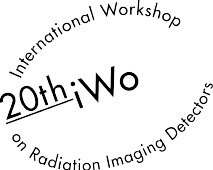Speaker
Description
ABSTRACT
Intense X-ray FEL beams allow research using experimental techniques: e.g. record chemical reactions on timescales previously not accessible (femto-second experiments), resolve atomic details of viruses and study new material structures. The European X-ray Free Electron Laser (XFEL.EU) is a research facility providing spatially coherent X-ray flashes in the energy range from 0.25$\,$keV to 25$\,$keV of unprecedented brilliance and with unique time structure: X-ray pulses with a 4.5$\,$MHz repetition rate arranged in trains with 2700 pulses every 10$\,$ms [1]. There are three beamlines (SASE1, SASE2 and SASE3), each hosting two scientific experiments. In order to gain information from the experimental data, properly characterized and calibrated X-ray detectors are required. Supplementing high repetition rate detectors at MHz speeds, detectors at 10$\,$Hz, matching the train rate of 10$\,$Hz, such as the ePix100a and the FastCCD will be used at the facility. These 2D silicon pixelized detectors use column-wise readout as CCDs or hybrid pixel detectors, with columns defined either on the sensor- (CCD) or ASIC-level (ePix). Characterization and analysis approaches of the FastCCD [2] and ePix100a [3] detectors are discussed and the performance of the detectors is evaluated using appropriate state-of-the-art analysis techniques. Figure 1 shows an Fe-55 single events spectrum measured with a FastCCD comparing uncorrected and corrected data, as analyzed with the XFEL.EU calibration tools. ![Figure 1. Fe-55 single events spectrum of the FastCCD comparing uncorrected and corrected data. Improvement of energy resolution after applying corrections is observable. FWHM is changing after corrections from ca. 573.1$\,$eV to ca. 422.6$\,$eV at 5.9$\,$keV. Red and green vertical lines show K$_{\alpha}$, respectively K$_{\beta}$ peak positions before (dotted) and after (dashed) corrections.] At XFEL.EU the FastCCD and ePix100a detectors are two of multiple detector designs with similar readout architectures in use, allowing us to compare analysis approaches and improve accuracy and efficiency of calibration and characterization across different charge shifting detectors technologies.
REFERENCES
[1] Altarelli, Massimo, et al. "The European x-ray free-electron laser." Technical Design Report, DESY 97 (2006): 1-26.
[2] Januschek, Friederike, et al. "Performance of the LBNL FastCCD for the European XFEL." arXiv preprint arXiv:1612.03605 (2016).
[3] Blaj, Gabriel, et al. "X-ray imaging with ePix100a: a high-Speed, high-resolution, low-noise camera." SPIE Optical Engineering+ Applications. International Society for Optics and Photonics, 2016.
(1): https://drive.google.com/open?id=12XdqAU9FfsFBj4eE-3zTUmvjpIPccSIO
